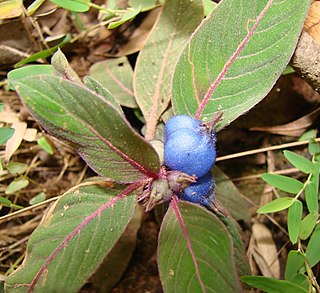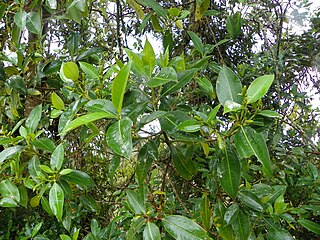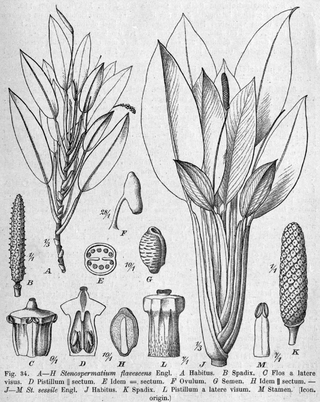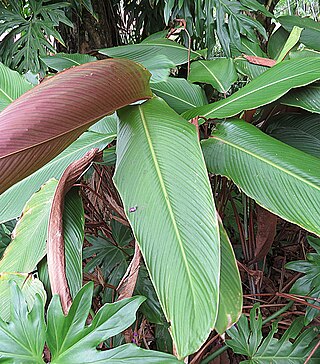| Renealmia | |
|---|---|
 | |
| Renealmia cernua | |
| Scientific classification | |
| Kingdom: | Plantae |
| Clade: | Tracheophytes |
| Clade: | Angiosperms |
| Clade: | Monocots |
| Clade: | Commelinids |
| Order: | Zingiberales |
| Family: | Zingiberaceae |
| Subfamily: | Alpinioideae |
| Tribe: | Alpinieae |
| Genus: | Renealmia L.f., conserved name |
| Synonyms [1] | |
| |
Renealmia is a plant genus in the family Zingiberaceae. Its members are native to tropical Africa and tropical America (Latin America and the West Indies). [1] [2] [3] [4] [5] [6] [7] In Peru, fruits and tubers are sources of indigenous dyes. [8] and indigenous medical treatments for leishmania and malaria [9] In Colombia, it is used to treat snakebite. [10] Bracts and leaves can serve as phytotelmata, retaining small quantities of water that offer habitat for other organisms. [11] [12]
Species include:
- Renealmia acreana Maas - Brazil (Acre State)
- Renealmia africana Benth. - western and central Africa from Togo to Angola
- Renealmia alborosea K.Schum. in H.G.A.Engler - Cameroon
- Renealmia alpinia (Rottb.) Maas - Latin America and the West Indies from Veracruz and Puerto Rico south to Bolivia
- Renealmia alticola Maas - Colombia
- Renealmia angustifolia K.Schum. in H.G.A.Engler - Espírito Santo
- Renealmia aromatica (Aubl.) Griseb. - Latin America and the West Indies from Veracruz and Puerto Rico south to Bolivia
- Renealmia asplundii Maas - Colombia, Ecuador, Peru
- Renealmia aurantifera Maas - Ecuador
- Renealmia batangana K.Schum. in H.G.A.Engler - Cameroon
- Renealmia battenbergiana Cummins ex Baker - Ghana, Ivory Coast
- Renealmia brachythyrsa Loes. - Cameroon
- Renealmia bracteata De Wild. & T.Durand - Congo-Brazzaville, Zaïre, Uganda
- Renealmia brasiliensis K.Schum. in H.G.A.Engler - Brazil
- Renealmia breviscapa Poepp. & Endl. - Brazil, Bolivia, Peru, Ecuador, Colombia
- Renealmia cabrae De Wild. & T.Durand - Congo-Brazzaville, Zaïre, Gabon, Cameroon
- Renealmia caucana Maas - Colombia
- Renealmia cernua (Sw. ex Roem. & Schult.) J.F.Macbr. - Latin America from Chiapas to Peru
- Renealmia chalcochlora K.Schum. in H.G.A.Engler - Colombia
- Renealmia chiriquina Standl. - Panamá
- Renealmia choroniensis Maas - Veenzuela
- Renealmia chrysotricha Petersen - Rio de Janeiro
- Renealmia cincinnata (K.Schum.) T.Durand & Schinz - west-central Africa from Ivory Coast to Congo-Brazzaville
- Renealmia concinna Standl. - Costa Rica, Panama, Colombia
- Renealmia congesta Maas - Costa Rica, Panama
- Renealmia congoensis Gagnep. - Congo-Brazzaville, Zaïre, Gabon, Cameroon, Cabinda
- Renealmia congolana De Wild. & T.Durand - Congo-Brazzaville, Zaïre, Rwanda, Uganda, Tanzania
- Renealmia costaricensis Standl. - Costa Rica, Panama, Colombia, Ecuador
- Renealmia cuatrecasasii Maas - Colombia, Ecuador
- Renealmia cylindrica Maas & H.Maas - Panama, Colombia, Ecuador
- Renealmia densiflora Urb. - Haiti
- Renealmia densispica Koechlin - Gabon, Cameroon
- Renealmia dermatopetala K.Schum. in H.G.A.Engler - Brazil, Bolivia
- Renealmia dewevrei De Wild. & T.Durand - Zaïre
- Renealmia dolichocalyx Maas - Ecuador
- Renealmia dressleri Maas - Panama
- Renealmia engleri K.Schum. in H.G.A.Engler - Kenya, Tanzania, Zambia
- Renealmia erythrocarpa Standl. - Costa Rica, Panama, Nicaragua
- Renealmia ferruginea Maas - Colombia
- Renealmia floribunda K.Schum. in H.G.A.Engler - Trinidad and northern South America
- Renealmia foliifera Standl. - Costa Rica, Panama, Colombia
- Renealmia fragilis Maas - Colombia, Ecuador
- Renealmia guianensis Maas - Guianas, Venezuela, northern Brazil, Venezuelan Antilles
- Renealmia heleniae Maas - Panama
- Renealmia jamaicensis (Gaertn.) Horan. - Bahamas, Cuba, Jamaica, Hispaniola, Puerto Rico
- Renealmia krukovii Maas - Colombia, Peru, Brazil
- Renealmia laxa K.Schum. in H.G.A.Engler - Cameroon
- Renealmia ligulata Maas - Costa Rica, Panama, Colombia, Ecuador
- Renealmia longifolia K.Schum. in H.G.A.Engler - Liberia, Ivory Coast
- Renealmia lucida Maas - Costa Rica, Colombia, Ecuador
- Renealmia macrocolea K.Schum. in H.G.A.Engler - Togo, Cabinda, Cameroon, Gabon
- Renealmia maculata Stapf in H.Johnston - Liberia, Ivory Coast
- Renealmia mannii Hook.f. - Bioko
- Renealmia matogrossensis Maas - Mato Grosso
- Renealmia mexicana Klotzsch ex Petersen - southern Mexico, Central America, Venezuela
- Renealmia microcalyx Maas & H.Maas - Brazil, Venezuela
- Renealmia monosperma Miq. - widespread from Panama east to the Guianas and south to Bolivia
- Renealmia nicolaioides Loes. - Venezuela, Colombia, Ecuador, Peru, Brazil
- Renealmia oligosperma K.Schum. in H.G.A.Engler - Ecuador
- Renealmia oligotricha Maas - Ecuador
- Renealmia orinocensis Rusby - Venezuela, Guianas
- Renealmia pacifica (Maas) Maas & H.Maas - southern Mexico, Guatemala, El Salvador
- Renealmia pallida Maas - Peru
- Renealmia petasites Gagnep. - Brazil
- Renealmia pirrensis Maas & H.Maas - Panama
- Renealmia pluriplicata Maas - Colombia, Ecuador, Central America
- Renealmia polyantha K.Schum. in H.G.A.Engler - Gabon, Cameroon, Congo-Brazzaville
- Renealmia polypus Gagnep. - Gabon, Cameroon, Congo-Brazzaville, Cabinda
- Renealmia puberula Steyerm. - Colombia, Ecuador
- Renealmia purpurea Maas & H.Maas - Peru
- Renealmia pycnostachys K.Schum. in H.G.A.Engler - Minas Gerais (probably extinct)
- Renealmia pyramidalis (Lam.) Maas - Lesser Antilles
- Renealmia racemosa Poepp. & Endl. - Peru, Bolivia
- Renealmia reticulata Gagnep. - Espírito Santo, Rio de Janeiro
- Renealmia sancti-thomae I.M.Turner - São Tomé
- Renealmia scaposa Maas - Costa Rica
- Renealmia sessilifolia Gagnep. - Ecuador
- Renealmia stellulata Steyerm. - Ecuador, Peru
- Renealmia stenostachys K.Schum. in H.G.A.Engler - Cameroon
- Renealmia striata (Stokes) Govaerts ex Maas - Jamaica
- Renealmia thyrsoidea (Ruiz & Pav.) Poepp. & Endl. - Brazil, Bolivia, Venezuela, Peru, Ecuador, Colombia, Suriname, Guyana, Trinidad, Panama, Costa Rica
- Renealmia urbaniana Loes. - Brazil, Peru, Ecuador, Colombia
- Renealmia vallensis Maas - Colombia
- Renealmia variegata Maas & H.Maas - Ecuador, Colombia, Panama
- Renealmia wurdackii Maas - Peru, Ecuador















